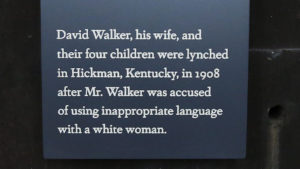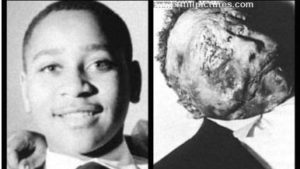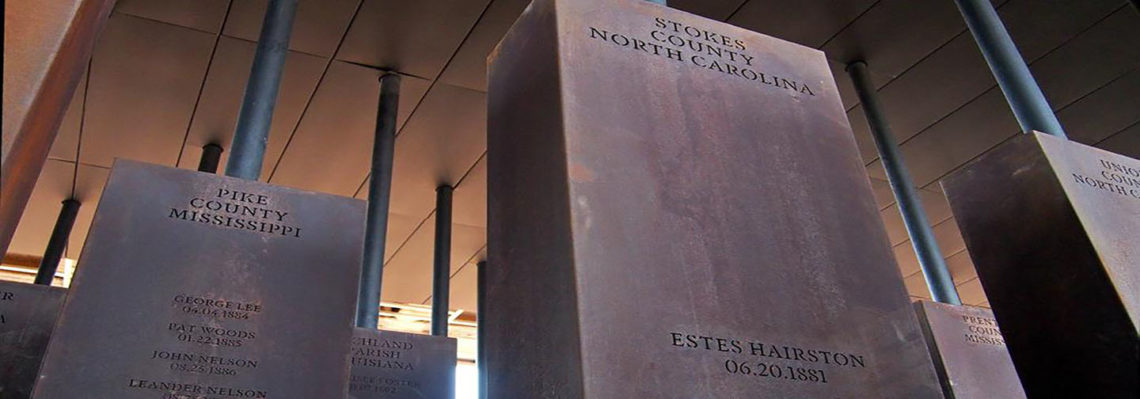Today marked the opening of the Equal Justice Initiative’s (EJI) Legacy Museum and National Memorial for Peace and Justice.
The 11,000-square-foot Legacy Museum is built on the site of a former warehouse where enslaved black people were imprisoned and is located midway between a historic slave market and the main river dock and train station where tens of thousands of enslaved people were trafficked during the height of the domestic slave trade.
The National Memorial for Peace and Justice is a memorial to the victims of “racial terror lynchings.” The site includes a memorial square with 800 six-foot columns that symbolize thousands of lynching victims and the counties and states where racial terror lynchings took place.
The columns are suspended from above representing public lynchings that happened in town squares across America. The hanging columns, evoking the image of hanging brown bodies, force visitors to grapple with the vast number of lynching victims in America.
 The memorial had a profound impact on me. As I found myself surrounded by 800 hanging brown columns, I was reminded that in 1959—just four years after 14-year-old Emmett Till was lynched in Money, MS—a 17-year-old boy, who would later become my father, was sent from his home in Shuqualak (pronounced “sugar lock”), MS to live with his mother’s sister in east central Indiana.
The memorial had a profound impact on me. As I found myself surrounded by 800 hanging brown columns, I was reminded that in 1959—just four years after 14-year-old Emmett Till was lynched in Money, MS—a 17-year-old boy, who would later become my father, was sent from his home in Shuqualak (pronounced “sugar lock”), MS to live with his mother’s sister in east central Indiana.
My grandparents feared their eldest son would become another victim of racial terror lynching. White men had come to their home to complain that my father had talked “disrespectfully” to white men in town earlier that day. Knowing the repercussions of such accusations, my grandparents sent their son away.
As I thought about the suffering Emmet Till experienced as white men brazenly abducted him from his great-uncle’s house and savagely beat him, mutilated his body, lynched him, and then shot him in the head before sinking his body in the Tallahatchie River (for a “crime” never committed), my entire body convulsed, tears welled in my eyes, and an unswallowable bulge filled my throat as I imagined the fate that awaited my father had my grandparents not sent him away that night. 
It’s estimated that more than six million black people fled the South as refugees and exiles as a result of racial terror lynchings. Much of my extended family fled Mississippi ending up in Anderson, IN, Chicago, IL, Omaha, NE, and Minneapolis, MN.
As a 53-year old African American college professor with graduate degrees from Princeton Theological Seminary and Yale University, I thought about who Emmett Till’s children might have become. I thought about the sheer volume of surviving and unborn children, grandchildren, and great-grandchildren of the more than 4,400 black men, women, boys, and girls lynched in America between 1877 and 1960.
I thought about the legacy of American impoverishment resulting from the barbaric atrocity of lynching. How many brilliant black people has our nation been denied as a result of lynchings?
While most Americans will never know my name, over the course of my ordinary life as a son, husband, father, friend, military veteran, minister, chaplain, counselor, social activist, college professor, and now blogger, I have had the privilege of impacting thousands of people.
Had my grandparents not saved my father from a lynching in Shuqualak, MS 61 years ago, I would have never been born. He would have never brought his nine brothers and sisters out of Mississippi. They may have never provided America with the dozens of children, grandchildren, and great-grandchildren who have helped make America a better nation and a more perfect union.
Lynchings have not only terrorized black Americans, but they also have impoverished America as a nation. We will never be able to imagine the contributions made by the hundreds of thousands of black Americans denied an opportunity to impact the world because of lynchings.
As I made plans to attend the opening of the Legacy Museum and the Memorial, I had a number of white people ask me, “What is the benefit of a museum and a memorial dedicated to the victims of slavery and lynching?” As someone who teaches about the ongoing legacy of racism, I’ve often had white people ask me, “Why do black people insist on living in the past and remembering slavery when we have come so far as a nation? Ironically, many of the people who ask these questions are the same people who romanticize America’s past with slogans like, “Make America Great Again.”
Americans are extremely selective regarding the past we reflect upon. Many Americans invoke a selective past in order to buttress a racist self-serving present.
Before leaving to attend the opening of the Legacy Museum and Memorial, I was able to share with people who asked me why there should be such a museum and memorial the words on the EJI webpage,
A history of racial injustice must be acknowledged, and mass atrocities and abuse must be recognized and remembered, before a society can recover from mass violence…. The National Memorial for Peace and Justice provides a sacred space for truth-telling and reflection about racial terrorism and its legacy.
Having now visited, I realize a greater benefit for me has been a renewed sense of appreciation for the unfathomable strength, fortitude, and determination not simply of “a people” but of “my people” to rise above the destructive violence that has shaped our nation in an attempt to experience the life, liberty, and pursuit of happiness desired by all people.
The legacy of black people in this country is that since America’s founding, black Americans have been living and dying not to “Make America Great Again” but to “Make America Great at Last.”
Thank you, EJI for the Legacy Museum and the National Memorial for Peace and Justice. May they inspire in all of us an appreciation for the unconquerable spirit of black Americans and promote a more hopeful commitment to racial equity and the just treatment of all people.





Leave a Comment